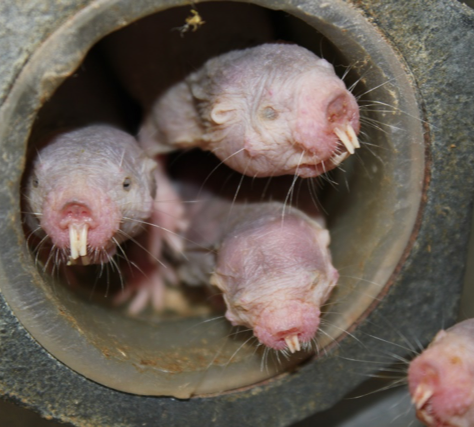Toughest animal in the world? Why naked mole rats don't feel pain
Naked mole rats do not feel certain types of pain - a potential evolutionary process to adapt to their crowded colonies.

Naked mole rats are one of the most resisilient animals in the world – they are known to never develop cancer, live for more than three decades, and do not feel certain types of pain. Scientists have now found out why that is, identifying what makes the rodent's sensory neurons different.
African naked mole rats are subterranean rodents that have been used in scientific experiments as they have the unique characteristic of not feeling certain types of pain. They do not respond in the same way to a thermal stimuli.
When humans and other rodents experience inflammation and tissue injury, the affected tissue becomed hyper sensitive. This means that stimuli such as high temperatures which are not normally painful become so – this is a phenomenon known as hyperalgesia.
An example of this is when entering hot water while sub-burnt, humans feel a sting on their skin. Naked mole rats do not experience this because they do not experience thermal hyperalgesia.
Scientists already have a good knowledge of the body's response during hyperalgesia, so studying it in naked mole rats is a good way to spot what is going wrong. The results of their investigations are published in the journal Cell Reports.
Slight change in receptor
Molecules known as nerve growth factors play a key role in inducing thermal hyperalgesia after an inflammation around sensory neurons. To do so, the molecules bind to a receptor called TrkA which initiates chemical signals that lead to the sensory neuron opening up and firing to tell the brain to register the pain.
Conducting a series of experiments with mole rats - for example making the rodents walk on red hot chilli peppers to test if they felt a burn - the researchers have discovered a small change in their TrkA receptor.

They compared the gene for the naked mole rat's TrkA receptor to those of 26 other mammals, and five other African mole rat species. This allowed them to identify a switch of just three amino acids, sufficient to create a slight variation to the TrkA receptor and make it less sensitive.
"Even though the naked mole rat's version of the TrkA receptor is almost identical to that of a mouse or a rat, it has a very significant effect on the animal's ability to feel pain," explained lead author Gary R. Lewin from the Max-Delbruck Center for Molecular Medicine in Berlin, Germany.
Hypo-functional not dysfunctional
Another important finding was that the receptor was not dysfunctional in mole rats but hypo-functional. This means that it would react to the nerve growth factors, but only at great concentrations. It could feel pain, but only if this pain was very important.
This may be the reason why the naked mole rats are able to survive with impaired nerve growth factors signalling, when normally, animals with mutations that completely shut down this signalling can have neuro-degenerative problems.
"We think evolution has selected for this tweak just subtly enough so that the pain signalling becomes non-functional, but not strong enough that it becomes a danger for the animal," says Lewin.
The scientists believe that this loss of thermal hyperalgesia in naked mole rats is the result of an evolutionary process. Losing thermal hyperalgesia might help the naked mole rats survive in their crowded underground colonies. They are in such close contact with one another that it can get uncomfortably hot, to the point that thermal hyperalgesia may not be helpful in this environment.
© Copyright IBTimes 2025. All rights reserved.






















